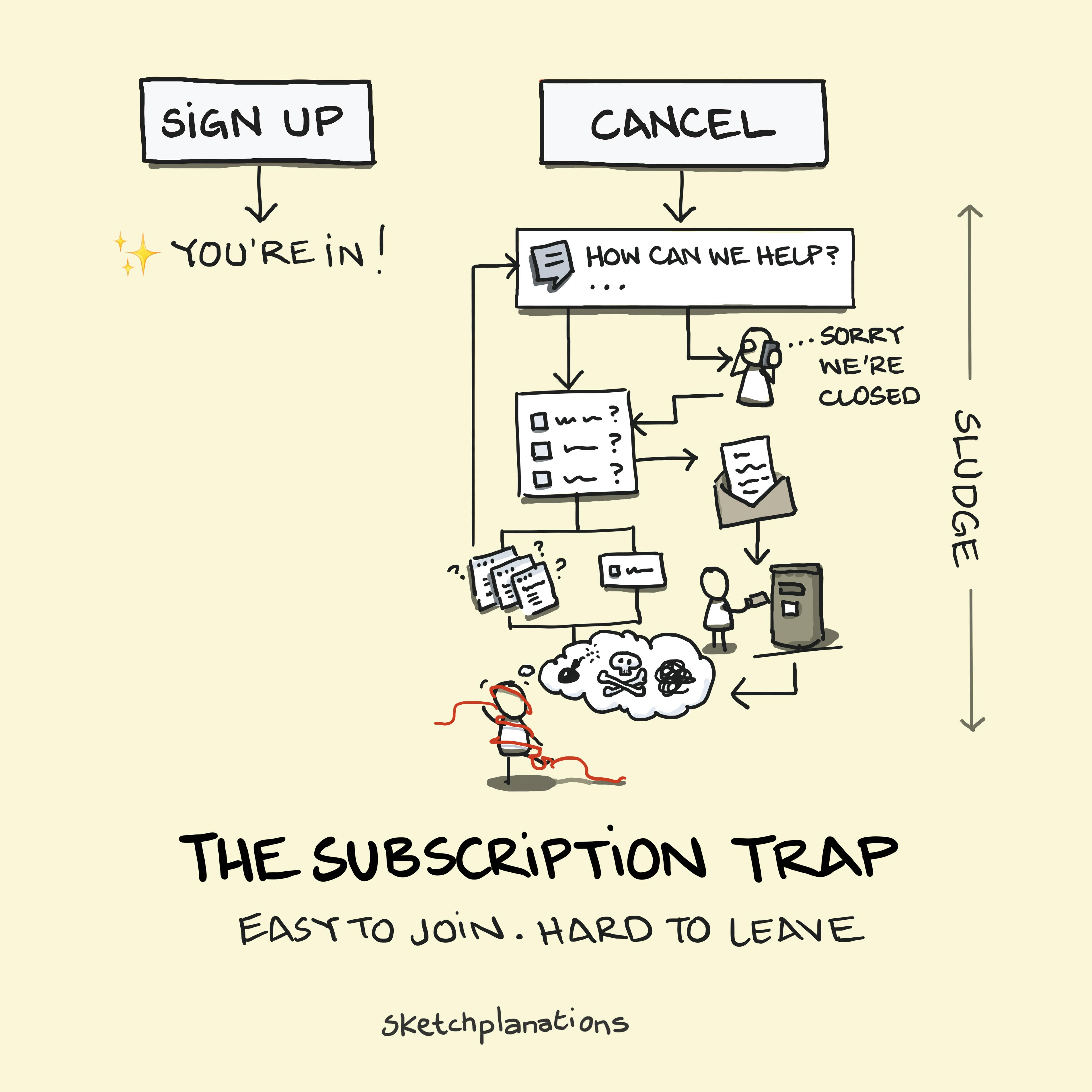The Subscription Trap

- Prints
- Copied!
👇 Get new sketches each week
Subscription traps are contracts that are easy to sign up for and hard to cancel. Subscription traps are sneaky. Just like Hotel California, "You can check out any time you like, but you can never leave."
What a Subscription Trap Looks Like
Sometimes, you may go from a free trial to a paid subscription without realising it. Sometimes, you may go months without noticing you're still paying for a subscription. Your contract may renew for a full year before you spot it. And when you try to cancel, you may find yourself jumping through hoops—compared to the few clicks it took you to sign up.
My experiences include:
- Searching for a cancel link online
- Turning to a customer support chat, which turns out to be a chatbot
- Finding the chatbot can't cancel for me or, more often, links me to the help article where I started and found I couldn't cancel online
- Eventually, being transferred to an agent and having to repeat everything
- Being given a phone number to call
- Finding they're closed because it's the weekend
- Scheduling a reminder to call back on Monday between meetings
- Calling, waiting in a queue (as opposed to the rapid response for prospective customers)
- Running out of time and forgetting to try again until the office is closed. <sigh>
Perhaps you'll recognise some of this.
Sludge and Why it Matters
The kind of bureaucracy and red tape you encounter when trying to cancel or do other things like claim on health insurance is sometimes called sludge . It's the friction stops us from getting things done.
In 2014, the UK government thought that unwanted subscriptions were costing people £1.6 billion a year —nearly 10 million of 155 million active subscriptions. They've held a consultation for measures to help avoid subscription traps and scams. California, for example, already has legislation requiring companies to offer online cancellation if they allow online sign-up.
Best practice includes
- Providing clear information about contracts before entering
- Reminders before moving from trials or discount periods to full-price
- Reminders before subscriptions renew
- Making it simple to cancel
Some Subscriptions are More Slippery than Others
We're less likely to get trapped in some types of subscription. If we subscribe to a box of groceries that appears at our door, we'll trip over the box rather than forget about it.
But online-only services or access-based platforms easily slip into the background. You may not notice they're still ticking along if you don't actively visit them. The only trace might be buried in your bank statement—monthly or even annual.
Economist Neal Mahoney and colleagues found a neat way to spot the subscription trap in action (pdf). They looked at cancellation rates over time and noticed something curious: when people's payment cards expired, they often didn't bother to restart the subscription with new card details.
That simple disruption—a forced pause—was enough for many people to realise they didn't need the service after all.
Incentives and Legislation
I've been on both sides of the subscription trap. It might be deliberate on behalf of a company. However, it can also be a product of incentives and environment.
Without new customer growth, a business doesn't last long. So, there's a lot of incentive to work on streamlined sign-up and onboarding. Hopefully, effort also goes into building a great product that makes people want to stay. However, once someone has decided to leave, there's often less incentive to make it a great experience, short of avoiding bad reviews.
I think it's generally not malicious—see Hanlon's razor. People know that cancelling isn't as easy as it should be, but they're measured on other targets that increase revenue or decrease costs. New projects are launched to do the same rather than "sink" money into making it easier for people to leave.
There will also often be a new customer onboarding team and no offboarding team at all (see Conway's Law).
This makes it a natural place for legislation to help out us punters just looking to cancel without spending all morning on the phone.
The Roach Motel
The subscription trap is similar to the unsubscribe roach motel anti-pattern for email subscriptions. A roach motel is a trap for cockroaches which is easy to get in and hard to get out.
Harry Brignull, author of Deceptive Patterns , gives a great example of contrasting subscribe and unsubscribe steps in his article on the unsubscribe roach motel .
Don't get Caught!
If you want to save money, reviewing your subscriptions and knowing what you're spending is a smart first step. We have a spreadsheet with all active monthly payments. A quick scan makes it easy to see what we still use or don't.
And yes, battle through the sludge and bureaucracy—it's worth it!
Related Ideas to the Subscription Trap
Also see:
- Dark patterns - using design to deceive
- The Shirky Principle - institutions will try to preserve the problem to which they are the solution
- Goodhart's Law - when a measure becomes a target, it ceases to be a good measure
- Campbell's Law - the more any quantitative social indicator is used for decision-making, the more likely it is to be distorted
- Conway's Law - software reflects the structure of the teams that built it
- You Get What You Measure
- Don't ask the barber if you need a haircut
- Amazon and Uber's Virtuous Cycle for Mega Growth
- The Business Flywheel
For interviews with Mahoney and Thaler (of sludge and nudge), see (once again) Freakonomics, Sludge, Part 2: Is Government the Problem, or the Solution?

